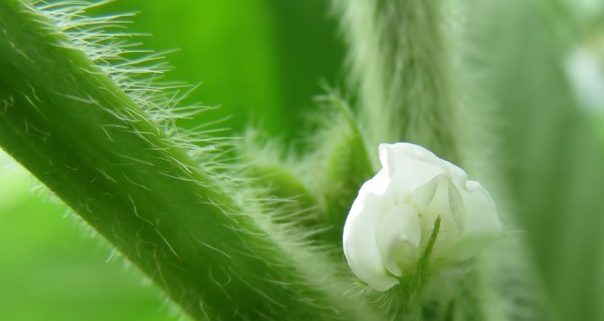Soybean Flowers, Herbicide Labels, and Wheel Track Damage…Oh My!
Authored by Shawn P. Conley and Rodrigo Werle
We are starting to get the many reports of soybean beginning to flower (R1) in our early planted situations. As we enter the soybean reproductive growth phase there are a few things to keep in mind. The first is that soybean will produce flowers for ~3 to five weeks, depending upon planting date and environment. During that time soybean will abort anywhere from 20 to 80% of the flowers that they produce. Generally it is the first and last flush of flowers produced that are most likely to be aborted.
| R1 soybean growth stage |
Next, the timing window for many POST-emergence herbicide applications in our early planted soybean are quickly closing if not closed already. Glyphosate labels indicate that applications can be made through R2 or full flower, however the spread of glyphosate-resistant waterhemp and other weeds across Wisconsin and beyond has led several farmers to adopt soybean varieties containing the novel herbicide resistance traits (Xtend [which confers resistance to glyphosate and dicamba],Xtendflex [which confers resistance to glyphosate, dicamba and glufosinate], Enlist E3 [glyphosate, glufosinate and 2,4-D] or LibertyLink GT27 [glyphosate and glufosinate]), which all provide effective herbicide options for POST-emergence broadleaf weed control. The application window for the POST-emergence herbicides associated with the aforementioned traits is also linked to soybean reproductive growth stages.
In Xtend systems, the registered dicamba herbicides Engenia and XtendiMax with VaporGrip Technology can be applied in Wisconsin until June 30 or up until R1 (first bloom; in other words, don’t apply if the soybeans are flowering), whichever comes first. Tavium plus VaporGrip Technology may be applied through the V4 growth stage or prior to June 30, whichever comes first.
In LibertyLink systems (LL, LLGT27, Enlist E3, or XtendFlex), glufosinate herbicides such as Liberty, Interline, etc. can be applied up to bloom or R1 growth stage (don’t apply if the soybeans are at R2 stage or advanced).
In Enlist E3 systems, the registered 2,4-D herbicides Enlist One and Enlist Duo should be applied through R1 growth stage.
When deciding the best time for a POST application, target small weeds, follow all label requirements and don’t spray under adverse environmental conditions.
Soybean developmental note: on average it takes ~ 4 days to move from R1 (beginning flower) to R2 (full flower) and ~10 days from R2 to the start of R3 (beginning pod).
Last but not least, wheel track damage made from ground applications may start to reduce yield. Sprayer wheel traffic from first flower (R1) through harvest can damage soybean plants and reduce yield (Hanna et al. 2008). Our research suggests that an adequate soybean stand (more than 100,000 plants per acre) planted in late April though mid-May can compensate for wheel tracks made when a field is sprayed at R1. Yield loss can occur, however, when wheel tracks are made at R1 or later in thin soybean stands (less than 100,000 plants per acre) or late planted soybeans. Regardless of stand, plants could not compensate for wheel tracks made at R3 (early pod development) or R5 (early seed development). The average yield loss per acre is based on sprayer boom width (distance between wheel track passes). In our trials yield losses averaged 2.5, 1.9, and 1.3% when sprayer boom widths measured 60, 90, and 120 foot, respectively. Multiple trips along the same wheel tracks did not increase yield loss over the first trip.
 |
| Spraying soybean at the R1 crop growth stage |
 |
| Wheel track damage to drilled soybean at R1 |
Hanna, S., Conley, S. P., Shaner, G., and Santini, J. 2008. Fungicide application timing and row spacing effect on soybean canopy penetration and grain yield. Agronomy Journal: 100:1488-1492.




